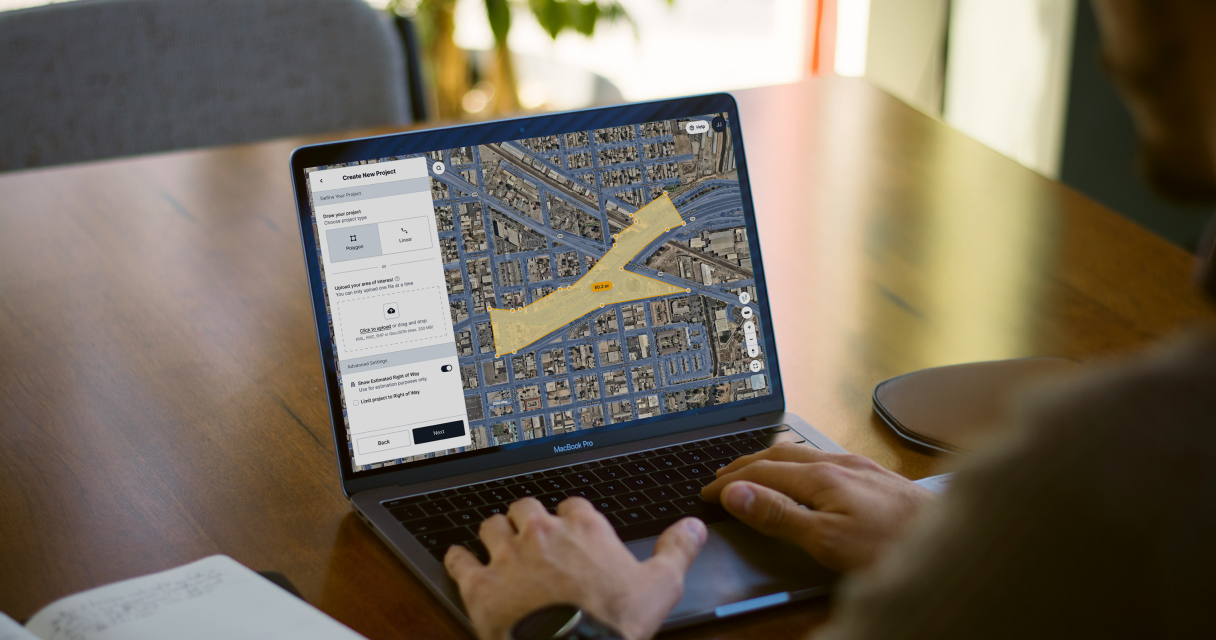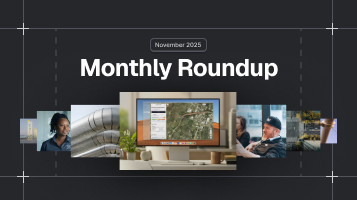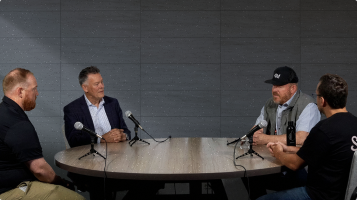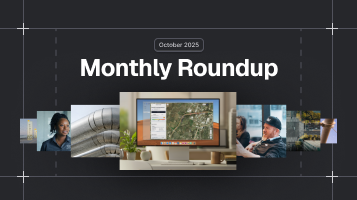From Landmine Clearance to Mapping the Subsurface: How 4M Is Transforming Infrastructure
Written by
.avif)
Chris Garafola
Published on
October 17, 2025


Table of contents
It may sound unbelievable to most people that we don’t have a centralized system showing where underground utilities in the US are buried. But that’s the status quo, and it makes every part of the construction process more difficult. Today, that’s changing with the growth of 4M Analytics.
Our founder and CEO, Itzik Malka, recently spoke to host Owen Drury on the Bricks & Bytes podcast about how he came up with the idea for 4M, how it was built from a tiny start-up into a company transforming the construction industry, and how 4M is changing the future of the industry and AI. Here’s a recap of the podcast highlights and Itzik’s insights.
Main Episode Takeaways:
- There’s an unmapped “8th continent” — the underground world, a dense network of utilities, delivering crucial services to our lives but also posing hazards for excavation. 4M was founded to reliably and instantly map those utilities, based on Itzik’s experience in the Israeli military as an explosive removal expert.
- The 4M business model provides significant value to three key groups: engineers, DOTs, and utility owners. And with a business model that maps the underground continuously and provides the same data to keep stakeholders aligned, it’s both useful and sustainable.
- Anywhere from 8% to 15% of every construction budget goes to contingency solely because of the hidden risk of unknown and unmapped utilities — and 4M has mapped 14 states and counting to change that status quo.
Creating an Opportunity From a Hidden Issue
Few founders can trace their startup origins to defusing landmines. But Itzik’s military background in explosive disposal became the unexpected foundation for tackling one of construction's biggest challenges: mapping what lies beneath our streets and properties.
After a decade in the IDF special forces, Itzik's path evolved from military service to humanitarian mine clearance work. This journey ultimately led him to discover a massive problem hiding beneath America's infrastructure projects.
“I'm going to build the Google Maps of the subsurface. You use Google Maps to see the road, and you're going to use 4M to see the below-ground world,” he says.
The Challenge: Understanding the “8th Continent”
The subsurface represents what Itzik calls the “8th continent”: a space that was once empty but has become one of the most dense, complicated environments hiding countless miles of infrastructure and services that we consume on a daily basis. Water mains, gas lines, fiber optic cables, and electrical conduits create an intricate web of lines beneath every street. Yet there's no comprehensive, reliable map of where these critical utilities actually lie.
The scale of this challenge is staggering. With 42 million dig requests annually in the US — equivalent to 169,000 construction projects per day — each project requires coordination between 50 to 60 different entities. From city planners to utility companies to construction crews, everyone needs to know what's underground.
“Anywhere from 8% to 15% of the contingency budget of every project relates to what goes beneath the ground. Nobody knows where and when things were buried," Itzik explains. “So this is what I'm bringing to the table: a digital social network for utility coordination, risk mitigation, and data management. People use our platform to speak with each other and make sure that they're going to be on time, delivering continuity to the public.”
The consequences extend beyond project delays and cost overruns. A tragic incident in Lexington, Missouri in April 2025 illustrated the deadly risks when a utility locator missed a section of gas pipeline, causing an explosion that killed a five-year-old child after a telecommunications installer hit the unmarked line. Such catastrophes have been the impetus for more regulation and industry response, and 4M is hoping to prevent such incidents from occurring again.
Traditional Methods Hit Their Limits
The current approach relies heavily on the 811 “Call Before You Dig” system — a free service funded by utilities that's essential for safety but struggling with volume and capacity.
The traditional process means utility data can be slow to arrive. After submitting a ticket, utility owners have 2 to 3 days to respond, but the entire coordination process typically stretches to 2 to 4 weeks. More complex projects requiring subsurface utility engineering can take 4 to 6 months of field work before excavation can begin.
This manual, fragmented approach results in incomplete data, project delays, and significant safety risks.
Building the Technology Solution
4M tackles this challenge through what Itzik describes as a “multi-source data fusion engine.” The utility AI mapping platform combines digitized construction blueprints, satellite and aerial imagery with time-lapsing capabilities, and GIS data from public sources. The AI algorithms can “predict the past” by analyzing decades of imagery to trace when and where infrastructure was installed.
“We are AI-native,” Itzik emphasizes. “We started building CPU menus with hybrid versions five years ago.” This early investment in artificial intelligence is now reaching what he calls a “tipping point”: the platform can now generate utility lines purely by AI in areas that lack documentation or data coverage.
The technology processes vast amounts of data through a structured pipeline where AI-powered engines extract and standardize information, validate and cross-check sources to detect inconsistencies, and infer missing data using geospatial analysis and pattern recognition.
4M has systematically mapped 14 US states and plans to expand to 22 by the end of 2025. Our approach focuses on publicly available data sources, starting with right-of-way information that represents about 95% of utility networks. The result: instant, high-confidence utility maps that replace months of manual field investigation.
Learning Through Market Reality
The path to product-market fit required hard lessons. 4M initially launched with a consumption-based pricing model that seemed logical: customers would pay as they used the service. The reality? “They didn't use it,” Itzik admits. “To be a really strong SaaS company, it's not just about addressing fundamental questions on a daily or weekly basis. It's about customers actually using your product.”
The challenge intensified during the October 7th attacks in Israel when 50 team members were called to military reserve duty. Unable to deliver promised service levels, the company faced a critical moment.
This crisis forced innovation. One team member figured out how to process an entire city's utility network in parallel rather than one project at a time, proving real-time feasibility was possible. The company pivoted to a project-based SaaS model, packaging subscriptions around construction projects rather than usage metrics.
Building Trust in Construction
Breaking into the relatively AI-shy utility and construction sectors required a deliberate approach. “The currency in this industry is trust,” Itzik says.
The company strategically targeted engineers first — a very selective audience who are quick to point out technological shortcomings. “If we got the trust of these guys, I knew we'd be in a good position,” Itzik notes. “At the beginning they said, ‘It's not good enough,’ and we reiterated every time. And once it was good enough and they started to use it on a daily basis, we realized that we needed to expand into the market.”
Once they earned engineers’ trust, expansion to state departments of transportation followed. 4M now has five paying DOT customers with a sixth expected by year's end. And they are currently expanding into the third customer sector of utility owners, advancing by region and by utility type — they recently signed a contract with their first natural gas client.
“Eventually, every one of the 50 to 60 entities and hundreds of professionals involved in one construction site are going to use our product to be educated anytime they want to know something about what's below.”
The Data Advantage
What sets 4M apart is the nature of their data asset. “We’re creating the data that's going to be ready to use right now. It's a generational product,” Itzik explains. “We’re mapping it once and keeping it up to date, but you get to use it every time without starting from scratch.”
This creates a sustainable competitive advantage. Unlike traditional software that requires continuous development to maintain value, infrastructure data becomes more valuable over time as it accumulates usage and validation from real-world projects.
The company's mission extends beyond efficiency gains. “We want to be supplemental to the damage prevention ecosystem,” Itzik explains, “and we want people to use us every time they want to know what's below the surface.” 4M does not replace existing systems like 811, but is complementary, providing the second layer of validation that construction projects desperately need.
Transforming Infrastructure Development
4M's platform represents more than a mapping tool — it's a form of infrastructure intelligence that enables teams to plan, design, and build smarter, faster, safer projects. The vision extends to becoming the industry standard for utility intelligence trusted by all stakeholders.
With strong advisory support from industry leaders, including the founder of subsurface utility engineering practices and former executives from major construction and mapping companies, 4M is positioned to reshape how America builds and maintains its critical infrastructure.
4M’s success ultimately serves a larger purpose. In a world with increasing demands on our underground infrastructure, accurate subsurface mapping isn't just a business case — it's an exciting opportunity for the construction industry to help communities build better together.
Want more? Listen to the full podcast episode here.
Recent blog posts

Our Newsletter
Join 7k infrastructure professionals
Get monthly insights on ways to build smarter, faster and safer with Utility AI.





